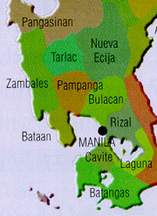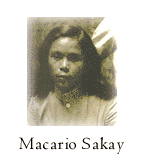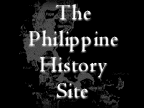Ethnicity
and the Creation of National Identity

Initially,
the Revolution appeared to be an entirely Tagalog affair.
The first eight provinces to rise in arms were all in the
Tagalog region and its adjacent areas: Bulacan, Nueva Ecija,
Tarlac, Pampanga, Manila, Laguna, Cavite, and Batangas. Even
among these provinces, fighting was minimal except for Cavite,
Bulacan, and, of course, Manila. Most of the principal revolutionary
leaders were Tagalogs, and their initial appeal of support
was directed towards the Katagalugan or the Tagalog
people. This was not surprising since prior to the Revolution,
Filipinos did not think of themselves as one homogenous race.
Identity was instead linked with regional ethnicity. The Spanish
policy of divisiveness aimed at effecting colonial rule promoted
and encouraged regional isolation and ethnic distinctions.
By the nineteenth century the term "Filipino" referred
to the Spanish insulares or those born in the Philippines.
The Filipinos in general were loathingly called indios
and their identity was rooted on their regional origin or
ethnic affiliation: Tagalog, Kapampangan, Cebuano, Ilocano,
Ilonggo, etc.
In the
first two years of the Revolution, battles raged mainly in
the Tagalog provinces. Outside the Katagalugan, responses
were varied. Pampanga, which was close to Manila, was uninvolved
in the Revolution from September 1896 to the end of 1897,
perhaps because the conditions which drove the Tagalogs to
rise in arms were not totally similar in Pampanga. For instance,
friar estates or church monopoly of landholdings which triggered
agrarian unrest in Tagalog areas was not pervasive in Pampanga.
Besides apathy, there were those, such as some Albayanos of
Bicol, who were even apprehensive of rumors of a "Tagalog
rebellion" aimed at ousting the Spaniards and exercising
Tagalog hegemony over the non-Tagalog ethnic groups. Historian
Leonard Andaya claims that what brought the Revolution to
the non-Tagalog areas was Aguinaldo’s policy of encouraging
his military officials to return to their home province and
mobilize local support. For instance, the Revolution came
late in Antique, and it was due to General
Leandro Fullon, an Antiqueno principalia general
of Aguinaldo, who went to his home province to spread the
Revolution. Even after the Revolution spread to the rest of
Luzon and the Visayas, there were still suspicions as to the
real motives of the Tagalogs. For example, the Iloilo elite
changed the name of their provisional revolutionary government
and called it the Federal State of the Visayas since they
did not want to recognize the supremacy of Aguinaldo and the
Tagalogs. They preferred instead a federal arrangement composed
of the three main island groups - Luzon, Visayas, and Mindanao.
These
reservations and suspicions by non-Tagalogs were somehow reinforced
by the initial writings and proclamations of key Tagalog personalities
of the Revolution. Bonifacio wrote a revolutionary piece which
he entitled "Ang Dapat
Mabatid ng mga Tagalog" or "What the Tagalogs
Should Know." Aguinaldo, in his memoirs, wrote chapters
entitled "The Tagalog Government Begins" and "Long
Live the Tagalogs." But in the absence of a general,
generic term to collectively refer to the inhabitants of the
archipelago, Filipino being a term originally reserved for
the Spanish insulares, Tagalog may have appeared to
the leaders of the Revolution as a logical substitute because
of its indigenous element.
 In
due time, however, Aguinaldo’s proclamations gradually
introduced the idea that all the inhabitants of the Philippines
are Filipinos. Tagalog became less used and in its place
Filipino was increasingly mentioned. The Revolution likewise
assumed a national character. The declaration of Philippine
independence was both significant and symbolic in the imagining
and forging of a Filipino nation-state. Although there was
a gradual acceptance of the term Filipino, nonetheless up
until the early American period, Tagalog was still occasionally
used. General Macario Sakay,
a Tagalog general who continued the war against the Americans
even after Emilio Aguinaldo was captured, called his government
in 1902 the Tagalog Republic, although its charter noted
that Visayas and Mindanao were included in his Republic. In
due time, however, Aguinaldo’s proclamations gradually
introduced the idea that all the inhabitants of the Philippines
are Filipinos. Tagalog became less used and in its place
Filipino was increasingly mentioned. The Revolution likewise
assumed a national character. The declaration of Philippine
independence was both significant and symbolic in the imagining
and forging of a Filipino nation-state. Although there was
a gradual acceptance of the term Filipino, nonetheless up
until the early American period, Tagalog was still occasionally
used. General Macario Sakay,
a Tagalog general who continued the war against the Americans
even after Emilio Aguinaldo was captured, called his government
in 1902 the Tagalog Republic, although its charter noted
that Visayas and Mindanao were included in his Republic.
|

